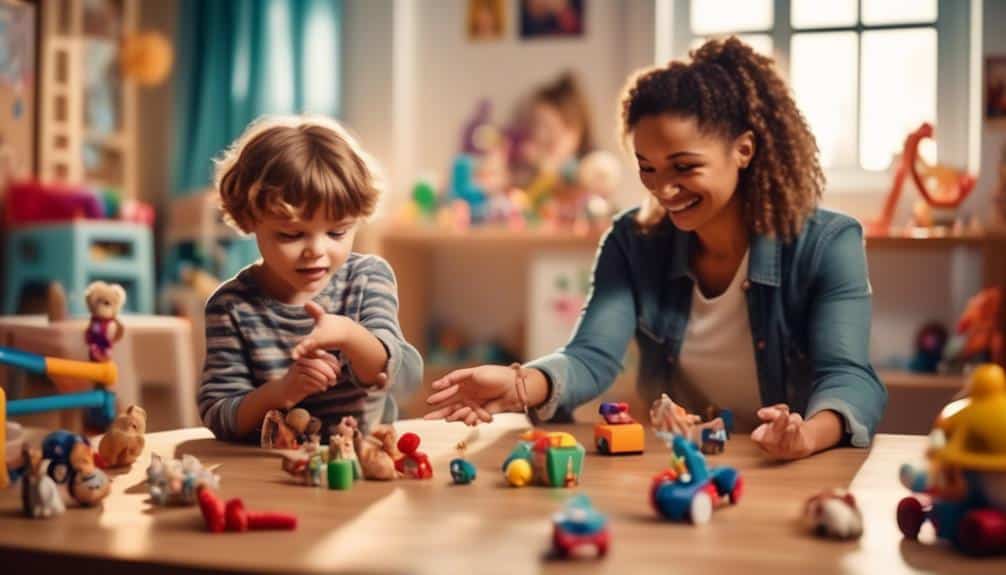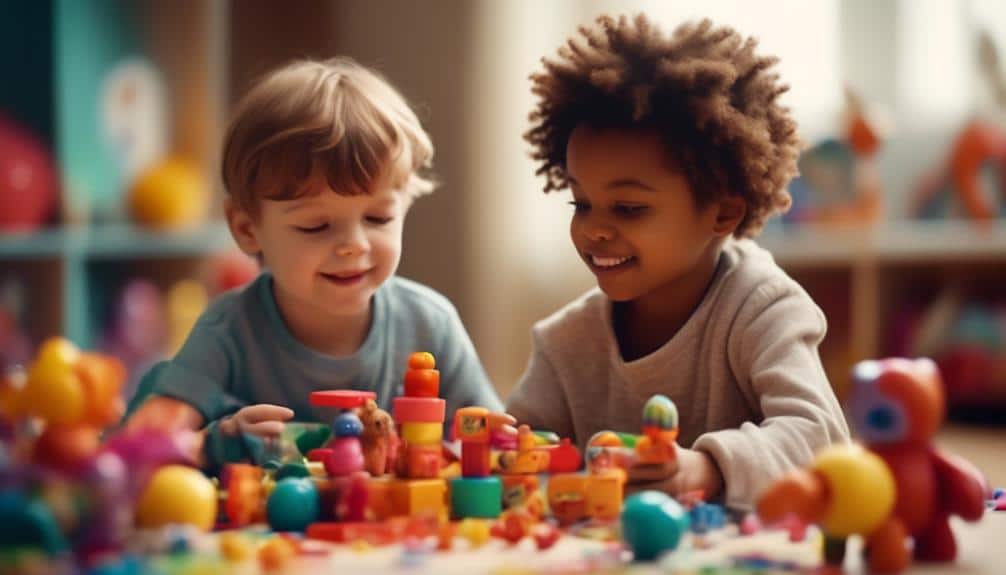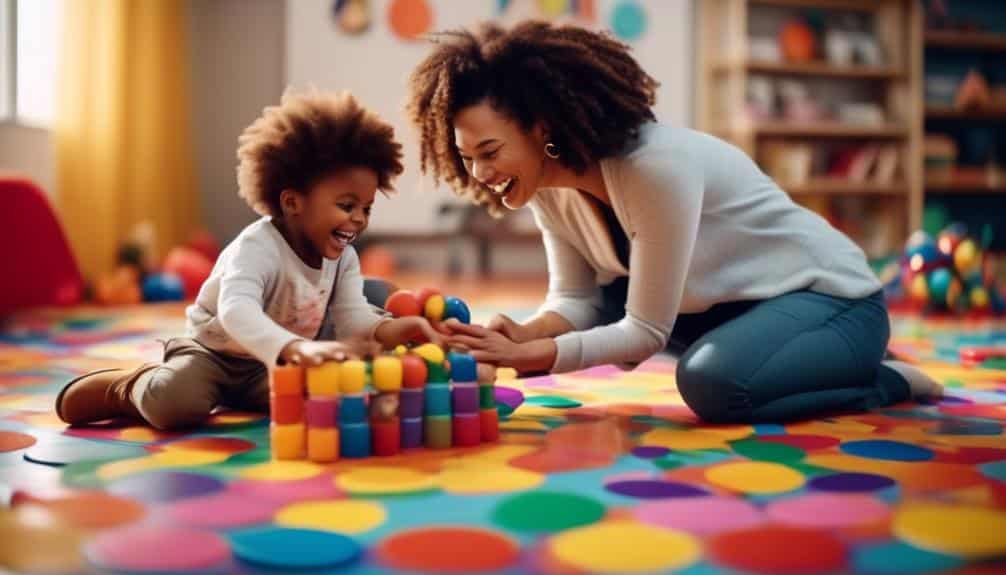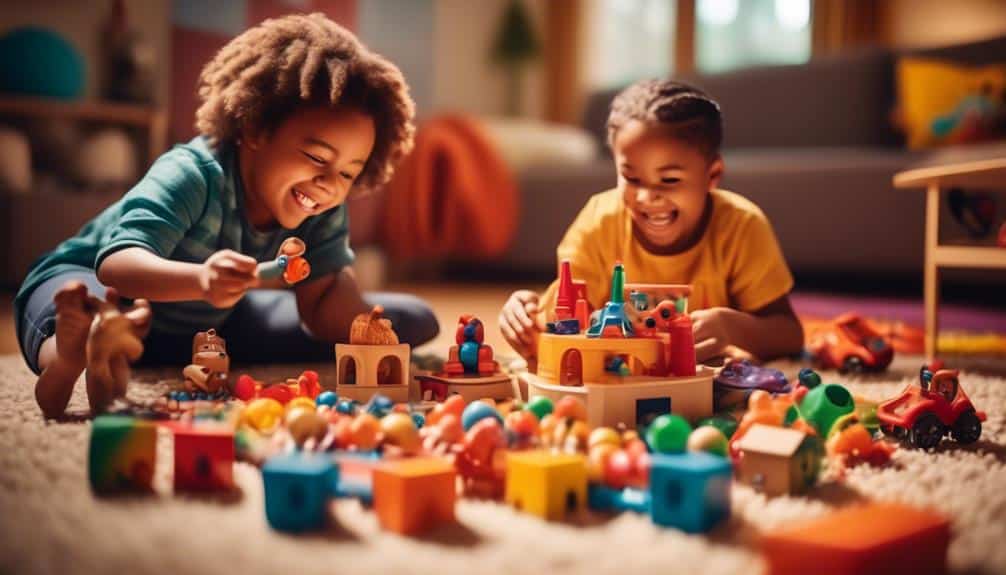The Developmental, Individual-difference, Relationship-based (DIR) model, or DIRFloortime, presents a dynamic and nuanced approach to fostering social skills in individuals with developmental differences, such as Autism Spectrum Disorder (ASD). Central to its methodology is the emphasis on respectful and tailored interactions that meet each child’s unique emotional and developmental needs. Examining the ten best DIRFloortime strategies, we uncover techniques designed to enhance reciprocal communication and deepen emotional connections, from prioritizing child-led play to integrating sensory integration therapy. These strategies align with current evidence-based practices and resonate with the intuitive understanding of child development professionals.
By implementing these thoughtful interventions, parents, educators, and therapists can establish a foundation for meaningful social engagement, setting the stage for a robust exploration of the interpersonal world as experienced by children with ASD. However, the efficacy of these strategies is not solely in their application but in the symphony they create when executed collectively, a harmony that unfolds in practice with striking implications for social skill development.
Key Takeaways
- Prioritize child-led play to promote the development of social skills.
- Encourage nonverbal communication to enhance interactions.
- Deepen emotional connections for meaningful social interactions.
- Embrace individual differences and tailor interaction approaches accordingly.
Prioritize Child-Led Play
By embracing child-led play, educators and parents can often enhance the development of social skills by attentively following the child’s lead in the play, fostering a sense of agency and confidence. By allowing children to steer play-based interactions, they engage in meaningful social exchanges and learn to assert themselves and interpret others’ emotional cues. This approach is rooted in respect for the child’s individuality and communicates trust in their capabilities, which is instrumental in building self-esteem.
Supporting a child’s play choices and joining in with genuine interest can create a rich environment for social learning. As adults participate without directing, they provide subtle guidance that helps children navigate the complexities of social interactions. This can be particularly evident when children choose activities that resonate with them, whether a favorite puzzle or an imaginative role-play game.
To optimize the benefits of child-led play, it is crucial to cultivate an environment that sparks curiosity and interaction. This involves offering a variety of toys and games that align with the child’s interests and being mindful of their cues. By doing so, adults can maintain engagement and adapt their support, ensuring that play remains a dynamic tool for social skills development.
Encourage Nonverbal Communication

Nonverbal communication, encompassing gestures, facial expressions, and body language, enhances a child’s social skills and should be actively encouraged within the DIRFloortime framework. For children with autism spectrum disorders, developing these nonverbal cues is vital for their social and emotional development. By consciously integrating strategies encouraging nonverbal communication, caregivers and therapists can foster a more inclusive and effective social learning environment.
- Mirror Nonverbal Cues
- *Reflect a child’s gestures*: This shows understanding and promotes mutual engagement.
- *Accept and expand on their expressions*: Encouraging children to express nonverbally a broader range of emotions.
- Provide Expressive Outlets
- *Art, music, and movement*: Offer creative channels for self-expression without the need for words.
- *Visual supports*: Utilize tools like pictures, symbols, or schedules to reinforce understanding and expression.
In practice, these strategies involve offering choices to the child and patiently waiting for their nonverbal response. This approach respects the child’s communication style and empowers them to make decisions and express preferences naturally. By valuing and reinforcing these nonverbal interactions, caregivers can significantly aid in the holistic development of a child’s communicative abilities.
Deepen Emotional Connections

Fostering deep emotional connections with children requires a foundation of open, genuine communication that prioritizes their feelings and experiences. Active listening is pivotal when engaging with a child; this conveys respect for their emotions and validates their experiences. By attentively responding to what they communicate, caregivers can foster a sense of safety and trust essential for deepening emotional bonds.
Creating shared, playful experiences is another avenue to deepen emotional connections. These activities offer rich opportunities for both emotional regulation and joyous interaction. In a nurturing environment, children feel more at ease to express themselves, which can lead to a more profound emotional connection with the caregiver.
Utilizing empathy is a powerful tool in strengthening these emotional ties. When caregivers approach situations with understanding and put themselves in the child’s shoes, they build a foundation of trust that is invaluable in any relationship. Through consistent empathetic engagement, children learn that their emotions are acknowledged and essential, further solidifying the emotional connection and enhancing their capacity for social interactions and relationships.
Focus on Back-and-Forth Interaction

Cultivating social skills in children often hinges on the dynamic of back-and-forth interaction, which is central to the DIRFloortime approach. This reciprocal engagement is a cornerstone for fostering not just communication but also for promoting profound social-emotional growth. By focusing on this interaction, we provide children with a foundational experience that is both nurturing and educational.
To effectively implement these strategies, consider the following:
- Utilizing Child-Led Play:
- Engage in reciprocal interactions that respect and follow the child’s interests.
- Allow the child to initiate and lead, scaffolding their ideas.
- Encouraging Responsive Communication:
- Promote turn-taking, showing enthusiasm when responding to the child’s actions or words.
- Use gestures and facial expressions to maintain the back-and-forth flow.
Being attentive to the child’s cues and responding with genuine interest is crucial to the success of the DIR/Floortime Model. Through these meaningful exchanges, a child learns to navigate the complexities of human interaction, laying down the pathways for lifelong social competencies. Practitioners and caregivers committed to serving others must embrace these interactions as opportunities to enrich the lives of children through every shared moment of connection.
Embrace Individual Differences

Embracing individual differences is a cornerstone of effective DIRFloortime practice, as it celebrates each child’s unique personality within the learning environment. By tailoring interaction approaches, therapists and educators can meet children where they are, supporting their particular ways of connecting and communicating. This personalized attention encourages a strength-based approach to learning, enabling children to thrive socially by leveraging their distinct talents and preferences.
Celebrate Unique Personalities
Recognizing each child’s unique personality and distinctive traits is fundamental in utilizing DIRFloortime strategies to enhance social skills effectively. By celebrating unique personalities, we foster a more prosperous, inclusive environment, particularly for children with ASD, who benefit immensely from such individualized attention.
- Embrace Individual Differences
- Tailor activities to each child’s interests
- Honor their unique developmental paths
- Celebrate Diversity
- Create a supportive atmosphere for self-expression
- Encourage community acceptance and understanding
This empathetic and practical approach guides us to engage with each child on their level. It encourages a growth-focused mindset, acknowledging and genuinely valuing differences and crafting a foundation for meaningful social interactions and personal development.
Tailor Interaction Approaches
Adapting interaction strategies to align with each child’s differences is a cornerstone of the DIRFloortime approach, fostering more effective and meaningful social engagements. Children with developmental delays must tailor interaction approaches, ensuring that each child’s unique needs and preferences are met with understanding and expertise.
| Strengths | Challenges | Preferences |
|---|---|---|
| Recognize and build upon | Respect and support through adjustments | Adapt to specific likes and dislikes |
| Celebrate achievements | Accommodate developmental pace | Align with comfort levels |
| Leverage for growth | Mitigate with tailored strategies | Consider sensitivities |
As DIR/Floortime Certified professionals, we can adapt our methods flexibly to cater to every child’s diverse social and emotional characteristics, creating a nurturing relationship that honors their individuality.
Foster Strength-Based Learning
Building on the foundation of personalized interaction strategies, fostering strength-based learning further amplifies each child’s potential by focusing on their inherent capabilities and interests. This approach, integral to the DIRFloortime method devised by Dr. Stanley Greenspan, is efficient for children with developmental disorders. It shifts the focus from deficits to abilities, enabling a more positive and engaging learning experience.
- Strength-Based Learning Principles:
- Recognizes individual differences as opportunities
- Encourages children to engage in activities that showcase their strengths
This method helps build self-esteem and promotes genuine interest and motivation, which are crucial for learning new skills. By embracing each child’s unique profile, strength-based learning lays the groundwork for holistic development and improved social interactions.
Incorporate Daily Activities

A tapestry of teachable moments for social skill enhancement through DIRFloortime is in the rhythm of everyday life. By weaving Floortime strategies into routine interactions and engaging children in playful exchanges during activities like mealtime or getting dressed, we can create a seamless learning experience. These consistent yet dynamic interactions foster social skills and a deeper parent-child connection.
Utilize Routine Interactions
Harnessing the power of daily routines, such as mealtime and bedtime, provides a rich foundation for integrating DIRFloortime strategies to bolster a child’s social and communicative development. By deliberately incorporating routine interactions into a child’s day, we create a natural context for enhancing social skills, a cornerstone of the Engaging Autism approach.
- Mealtime
- *Initiate a game of passing dishes* to foster turn-taking.
- *Discuss flavors and textures* to engage in meaningful conversation.
- Bedtime
- *Create a storytelling ritual* to encourage imagination and emotional sharing.
- *Involve the child in choosing pajamas* to promote decision-making and self-expression.
Embracing these moments transforms everyday activities into opportunities for growth, ensuring that social learning is consistent and joyfully anticipated.
Engage Through Play
Transforming playtime into a dynamic tool for growth, DIRFloortime seamlessly integrates into daily activities, fostering social engagement and communication. Therapy helps children use their natural interests as a springboard for connection and relationship-building by incorporating play into routines like mealtime and bedtime. Engage through play by crafting interactive and meaningful play sessions that capture the child’s attention and create a strong emotional bond. This approach promotes communication and supports the child’s social development. Utilizing daily routines as a framework for Floortime allows for consistent, play-based interactions, providing children with a secure base from which they can explore and engage with their environment, enhancing their social skills naturally and enjoyably.
Use Playful Obstruction Techniques

When skillfully applied, playful obstruction techniques can significantly enhance a child’s ability to develop social skills through engaging and problem-solving play activities. These techniques involve creating scenarios that gently challenge the child, prompting them to navigate minor setbacks creatively and responsibly. Here are ways to implement these strategies effectively:
- Introducing Playful Obstacles
- Set up a game where the child must solve a puzzle to “unlock” the next step in the activity.
- Create a playful barrier in a physical game, like a soft pillow fort, that the child must figure out how to navigate around or through.
- Promoting Flexible Thinking and Persistence
- When the child encounters an obstruction, please encourage them to think of multiple solutions.
- Praise efforts and brainstorm to overcome the playful challenges, reinforcing that persistence pays off.
Foster Peer Play Opportunities

Creating opportunities for children to interact with peers through playdates and structured activities is a fundamental strategy for fostering their social skills, especially for those with autism spectrum disorder (ASD). By arranging playdates with peers who share similar interests, children are more likely to engage and feel motivated to interact, which can lead to meaningful social connections.
Incorporating structured group activities that require cooperative play and turn-taking can be particularly beneficial. These activities provide a framework for interaction and teach children the importance of social norms such as sharing and waiting for their turn. Such group settings can also be an excellent ground for practicing cooperative problem-solving, an essential skill for social development.
Parallel play, where children play alongside each other, can be a comfortable introduction to social interaction for those who may be overwhelmed by direct engagement. By supporting and facilitating communication between peers during these play scenarios, adults can help children with ASD to gradually build relationships and participate in reciprocal play, enhancing their capacity to form and maintain social relationships.
Integrate Sensory Integration Therapy

Building on the foundation of peer play opportunities, Sensory Integration Therapy offers another avenue to enhance social skills by helping individuals with ASD process and respond to sensory stimuli more effectively. This therapeutic approach is grounded in the understanding that sensory processing difficulties can significantly impact social interactions. By incorporating Sensory Integration Therapy into a child’s routine, parents and professionals can foster an environment where children are better equipped to navigate the complexities of their sensory experiences.
When considering Sensory Integration Therapy, it’s crucial to recognize:
- The Value of Sensory Integration Therapy:
- Helps improve attention and regulation
- Promotes better social engagement and interaction
- Implementation Strategies:
- Engage in activities that stimulate various senses (touch, taste, smell, sight, sound)
- Work with therapy services to create a personalized plan.
Sensory integration therapy, pioneered by A. Jean Ayres and further developed by experts such as Serena Wieder, is not a standalone solution but rather a complement to other therapeutic strategies like the DIRFloortime approach. It requires the expertise of trained therapists who can tailor activities to the unique needs of each individual. Embracing a multi-faceted approach, integrating sensory integration therapy can significantly improve a child’s social development and overall quality of life.
Establish Rhythmic Patterns of Interaction

To foster meaningful social exchanges, it is essential to establish rhythmic patterns of interaction that resonate with the child’s natural tendencies and rhythms. This approach helps children find comfort in the predictability of social encounters and enhances their ability to engage with others. Therapy techniques that embody this strategy include joining in the child’s activities, using time delays, and being mindful of environmental distractions.
To evoke emotion and illustrate the impact of these techniques, consider the following table:
| Action | Emotion Evoked | Outcome |
|---|---|---|
| Joining child’s play | Joy and acceptance | Fosters trust and openness |
| Pausing and waiting | Anticipation and curiosity | Encourages initiation of interaction |
| Removing distractions | Calm and focus | Enhances quality of engagement |
| Matching the child’s level | Connection and empathy | Strengthens the bond and interaction |
Frequently Asked Questions
What Makes the Best DIRFloortime Strategies?
The best DIRFloortime strategies excel in creating developmental interventions that prioritize natural learning environments. These approaches are adept at leveraging interactive play, skillfully following the child’s lead to provide tailored support for both emotional and cognitive growth.
What Is the DIR Model of Education for Autistic Children?
The DIR Model is an educational framework for autistic children, emphasizing developmental stages, individual differences, and relationships as foundational to fostering learning and emotional growth in a supportive, evidence-based approach.
What Is the DIR/Floortime Technique?
The Floortime technique is an interactive therapy that encourages communication and emotional growth through play, fostering natural developmental progress in children, particularly those with autism and other developmental challenges.
How Is Floortime Different From ABA?
Floortime differs from ABA by emphasizing child-led interactions focused on emotional and social development through play. At the same time, ABA is more structured, focusing on behavioral responses to specific stimuli and reinforcement.
Conclusion
Autism Spectrum Disorder (ASD) is a developmental disorder that can cause difficulties in social and emotional development, cognitive growth, and motor skills. Children with autism require tailored approaches to therapy, such as the developmental, individual differences, and relationship-based (DIR) approach, also known as Floortime. This approach promotes child-led play-based interactions that help foster social communication skills, emotional skills, and problem-solving skills. Parents, occupational therapists, and speech therapists can work together to create a supportive environment for the child’s growth. Studies have found that children who receive Floortime therapy significantly improve their adaptive behavior, communication skills, and cognitive development.
One pilot study found Floortime therapy was particularly effective for children with challenging behaviors because it allowed for playful interactions and emotional connections. Parents of children with autism can also participate in a parent training program to learn how to use this child-led approach at home.
Occupational therapists can help children with autism develop daily living and sensory processing skills through a sensory diet and sensory input. Speech therapists can assist with auditory processing and interpersonal skills. Behavioral therapy can also be helpful for challenging behaviors.
DIR/Floortime therapy aims to create meaningful connections and affective interactions that help the child develop abstract, creative, and emotional thinking. It is a practical and effective intervention approach for children and adolescents with autism spectrum disorders.
In conclusion, children with autism require a supportive environment and an individualized approach to therapy that promotes their growth and development. The Floortime approach, emphasizing child-led play-based interactions and emotional connections, is a practical approach to treatment. Parents, occupational therapists, speech therapists, and behavioral analysts can work together to help children with autism develop their cognitive and emotional intelligence in a comfortable environment.


Recent Comments